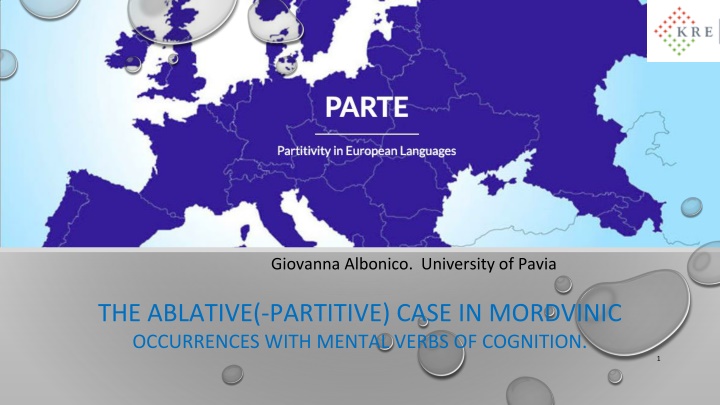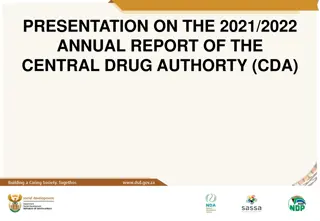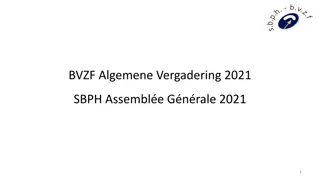
Ablative-Partitive Case in Mordvinic Languages
Explore the Ablative-Partitive case in Mordvinic languages, Erzya and Moksha, focusing on low transitivity, mental verbs of cognition, and object marking nuances. Discover how this case marks the object of certain verbs and its evolution from spatial separative functions.
Download Presentation

Please find below an Image/Link to download the presentation.
The content on the website is provided AS IS for your information and personal use only. It may not be sold, licensed, or shared on other websites without obtaining consent from the author. If you encounter any issues during the download, it is possible that the publisher has removed the file from their server.
You are allowed to download the files provided on this website for personal or commercial use, subject to the condition that they are used lawfully. All files are the property of their respective owners.
The content on the website is provided AS IS for your information and personal use only. It may not be sold, licensed, or shared on other websites without obtaining consent from the author.
E N D
Presentation Transcript
Giovanna Albonico. University of Pavia THE ABLATIVE(-PARTITIVE) CASE IN MORDVINIC OCCURRENCES WITH MENTAL VERBS OF COGNITION. 1
OUTLINE Introduction: Mordvinic languages (Erzya and Moksha) and transitivy. The ablative-partitive in Erzya and Moksha Low transitivity and APA Corpus and Data Results 2
MORDVINIC LANGUAGES (ERZYA AND MOKSHA) URALIC family, official languages of the republic of Mordovia (Saransk) 744,237 Mordvin speakers (2010) Rich inflectional systems NPs: definite, indefinite, possessive declension. + rich case system Verb: 3 tenses, 7 moods and 2 conjugations: subjective (SC) and objective (OC) the verb may agree with the subject (SC) , or with both the subject and the object (OC), 3 IntroductionMordvinic AP AP and mental verbs Corpus&data Results
OBJECT MARKING, DEFINITENESS AND AGREEMENT The transitive sentence in both Erzya (E) and Moksha (M) displays a high degree of variation as regards both the choice of the verbal conjugation and the marking of the object. The main variation is determined by the definiteness of the object > only a definite object in the genitive- accusative case may trigger the OC other cases do not trigger the OC, even if definites. The indefinite object is mainly expressed by the basic (unmarked) Nominative + subjective conjugation Moreover, the verbal aspect plays a role in the choice of the conjugation and in the object marking. The OC is generally associated only to perfective aspect but with some mental verbs is also compatible with imperfective aspect. Otherwise, the imperfective aspect is expressed by constructions with the inessive case 4 IntroductionMordvinic AP AP and mental verbs Corpus&data Results
THE MORDVINIC ABLATIVE-PARTITIVE Furthermore, the ablative-partitive (AP) case (E:-do/-d e and M:-da/-ta) occurs to mark the object of some transitive verbs. verbs of ingestion and some low transitivity verbs ( K:84 MKM:64-65. ) Beyond object marking, the AP covers a variety of other meanings, often related to the original separative function. The proto-Uralic ablative was a spatial separative case. Mordvinic AP, as well as Balto-Finnic and Saamic partitive, developed other functions related to the marking of the object of transitive verbs. 5 IntroductionMordvinic AP AP and mental verbs Corpus&data Results
THE MORDVINIC ABLATIVE-PARTITIVE (2) Generalized unboundness marking functions (Kiparski 1998) have been later developed by the Balto- Finnic partitive, both on an NP (indefiniteness) and on a VP (imperfectivity) level. Mordvinic shows more conservative features. According to some studies, E and M bear evidence of the original function of the AP Argument (APA) in the transitive sentence (Gr nthal (forthcoming) , Kiparsky 1998: 302). Traces of the original separative function of the AP are present in both E and M. Fixed spatial expressions as E kudo-s kudo-do 'house-ILL house-ABL' from house to house'. Occurrence with some postpositions meaning 'besides' or 'before' Second term of the comparative 6 IntroductionMordvinic AP AP and mental verbs Corpus&data Results
DEFINITE AND INDEFINITE AP Moreover, the mordvinic AP may be morphologically definite or indefinite, with some differences between E and M. In E the definite AP is formed by adding a definite marker to the ablative case. E kudo-do-n't' 'house-ABL-DEF', kudo- t n e-d'e 'house-PL.DEF-ABl' In M the definite AP is expressed by a postpositional construct with the postposition ezda 'PP:ABL (with an NP in the GEN-ACC ). ! The definite (coaffixal) AP of M differs also functionally. It occurs to compensate the elative case (the default case denoting direction from ). (1) T s orma-s this letter-DEF.NOM Moksha P et -n ezda, PP:ABL i carry-PST.3PL>3SG 3SG.GEN yesterday kand z son is ak. P.-GEN and This letter is from Peter; it was delivered yesterday' 7 Introduction Mordvinic AP AP and mental verbs Corpus&data Results
AP ARGUMENTS: SUBJECTS AND QUANTIFICATION Within existential quantified expressions the subject may occur in the AP, in both E and M. (2) a. Erzya Mi ki a-t n e-d e lamo, rami a-t n e-d e a lamo. There are many sellers but few buyers. b. Moksha E el j-da p ks -el , aba-da full-BE.PST.3SG a semboda lamo-l swimmer-ABL child-ABL but most A.LOT-BE.PST.3SG It was full of swimmers but most of all there were children.' (MKM 65) 8 IntroductionMordvinic AP AP and mental verbs Corpus&data Results
AP ARGUMENTS: INGESTION VERBS With verbs of ingestion the AP is used to express the meaning 'part of' with a semantic difference between definite and indefinite form. (3) Erzya a. INDEFINITE QUANTITY OF A GENERIC REFERENT Son im- 3SG drink-PST.3SG S/he drank/was drinking tea. (Alhoniemi 1991: 21) aj- e. tea-ABL b. INDEFINITE QUANTITY OF A SPECIFIC REFERENT Son im- 3SG drink-PST.3SG S/he drank/was drinking (of) this liquor. (Alhoniemi 1991: 21) e this vina-do- . liquor-ABL-DEF 9 IntroductionMordvinic AP AP and mental verbs Corpus&data Results
AP AND LOW TRANSITIVITY VERBS Across languages, partitivity is associated to low transitivity predicates and particularly to those that do not indicate a change of state. (Luraghi & Kittil 2014:44) > states or activities. Also in Mordvinic, some low transitive verbs occur with an APA. Among these, some mental verbs of emotion, cognition and perception. the subject of these verbs is an experiencer, characterized by a low degree of agentivity. ! Low transitive verbs with an agentive subject as 'to look for' , 'to wait'( pursuit verbs) do not take AP arguments. These are typically found with an inessive object. >The use of the AP is also associated to a low degree of agency of the subject. 10 IntroductionMordvinic AP AP and mental verbs Corpus&data Results
A. VERBS OF EMOTION In both E and M the verb pel'ems to be afraid of' takes an APA, as well as other expressions of emotion as 'to be ashamed of'. The AP occurs on the element causing/originating the emotion. This kind of use of the AP, present in other Uralic languages, derives from an archaic construction connected to the separative meaning (Gr nthal (forthcoming)). b. Erzya Viz d -an (4) a. Moksha Son koda tol-da he how [M] He was so afraid of fire. (MKM 66) pel -s fear-PST.3SG loman- t n e-d e fire-ABL be.ashamedd-PRS.1SG person-DEF.PL-ABL 'I feel ashamed in front of other people' (Bartens 1996:41) c. Erzya Kets -an rejoice-PRS.1SG this-ABL 'I am pleased with this' t e-d e 11 IntroductionMordvinic AP AP and mental verbs Corpus&data Results
B. TOPIC OF DISCUSSION AND MENTAL VERBS OF PERCEPTION AND COGNITION Moreover, some mental verbs of cognition and perception may show an APA in alternation to other cases. This use seems to be present only in E. It has been described in connection to the occurrence of the AP with verbs of speech activity. > the AP in this case denotes the topic of discussion. (5) Erzya Mon sod-an, 1sg I know what he is going to talk about (EKS:2011). mez -d e son karm-i what-ABL 3SG start-PRS.3SG korta-mo. talk-INF know-PRS.1SG Likewise, the APA is found with mental verbs of cognition in association with the topic of mental activity or state, see GMJa (1962:122), KS:66. and with verbs of perception verbs, as mar'ams 'to hear (about)' 12 IntroductionMordvinic AP Results AP and mental verbs Corpus&data
AIM OF THE STUDY analyze the cognitive verbs occurring with an APA. analyze how the AP alternates with other cases, and what are the semantic motivations at the basis of the alternation compare the occurrences of the AP in E and in M. compare the distribution of definite and indefinite AP . 13 IntroductionMordvinic AP AP and mental verbs Corpus&data Results
VERBS I selected different kinds of cognitive verbs , dividing them according to their lexical meaning and their telic and/or atelic features [Luraghi 2020:28-34] A. change of mental state. [E] arkod'ems [M] aRkod'ems 'to understand' B. mental state /inception of mental state. [E/M] sodams 'to know' C. mental activities . [E] ars'ems [M] ar's'ms 'to think'. D. memory: alternatively coded as activities/spontaneous change of state. [E] stuvtoms, [M] jukstams 'to forget' 14 IntroductionMordvinic AP AP and mental verbs Corpus&data Results
DATA AND ANALYSIS corpus: MokshEr journalistic. unannotated extraction from two sections of almost the same size. Erzya: Syatko 2002-2008 Moksha: Moksha Pravda 2003-2008 Extraction of finite verb forms in the OC and SC and selection of the contexts where the object was represented by an NP. Functional analysis of the distribution of the APAs of cognitive verbs and of the alternances with other cases in the object marking. 15 IntroductionMordvinic AP AP and mental verbs Corpus&data Results
RESULTS DISTRIBUTION OF THE AP WITH COGNITION VERBS IN ERZYA As expected, only E shows a systematic use of the AP to mark the object of cognitive verbs Erzya AP GEN-ACC NOM others ar's'ems 'to think' 99 (51%) 25 (13%) 60 (28%) 15 sodams 'to know' 77 (27%) 147 (52%) 51 (18%) 8 stuvtoms 'to forget' 18 (10%) 148 (85%) / 7 Among verbs of cognition, APAs are generally absent with verbs that entail a change of state as arkod'ems 'to understand'. The AP is the main case marking the object of the verb ar's'ems 'to think' while sodams 'to know', stuvtoms 'to forget' are mainly found with the GEN-ACC (+ OC). 16 IntroductionMordvinic AP AP and mental verbs Corpus&data Results
ERZYA AP AND VERBAL SEMANTICS With all the verbs analyzed, the AP participates in semantic motivated alternations with other cases marking the same syntactic argument. The alternations involving the AP seem related to a modification in the verbal semantics rather than to particular object features. The AP occurs with the atelic verb denoting an activity 'to think' and with verbs that may be interpreted as telic (change of state) or as atelic depending on the context, as 'to know, recognise' and memory verbs . With these verbs the AP occurs always in association with an atelc interpretation of the predicate. For example, with sodams 'to know, to recognise', the AP is always associated to a state. 17
[E] AR'S'EMS 'TO THINK' [E] ar's'ems is an activity verb, frequently found with an APA. It may occur as a telic creation predicate if the object is in the GEN-ACC and the verb in the objective conjugation . APA: 'to think (about)' (6) think-PST.1SG>3 A -i i- e- di ija ava- e- e. wife-ABL-DEF and other woman-PL.DEF-ABL 'I thougt about my wife and the other women' OC, GEN-ACC: 'to invent/design' (7) Paz-o loma e- a -iz'e? a -iz'e. este loma -e kije god-GEN.DEF human-NOM.DEF think-PST.3SG>3SG then human.beeing-GEN.DEF who think-PST.3SG>3SG 'The human being invented god. But then who invented the human being ?' 18 IntroductionMordvinic AP AP and mental verbs Corpus&data Results
[E] STUVTOMS 'TO FORGET' The meaning of the verb [E ] stuvtoms with a APA is limited to the meaning of 'not thinking about something'. To express the loss of memory the construct with the ACC-GEN occurs. (8) AP: ' working memory' A ak vejke- e- stra eg- e stuv - : kuvaka-t. But one-ABL-DEF strategist-PL.DEF forget-PST.3PL summer-GEN day-PL.DEF very long-PL 'But the strategists forgot one thing: during the summer days are very long' kize- i- e ve (9) GEN-ACC: loss of memory Moda-n t Earth-GEN.DEF smell-POSS:GEN.3SG-CLT I forgot also the smell of the soil in e-nze-jak stuvt-iz e forget-PST.3SG>3SG 19 IntroductionMordvinic AP AP and mental verbs Corpus&data Results
[E] SODAMS 'TO KNOW' With the verb [E] sodams, The construct with the APA is mainly used to expresses indirect knowledge, with the meaning of 'to know about (10) (10) AP 'to know about' a. Pa ak, kiak sod-i who Aga baba- ora-do-nzo-jak? man-ABL-POSS:3PL-CLT well know-PRS.3SG A. Baba-GEN 'Well, and who knows about the sons of baba Aga?' b. si a sod-i 3PL zijan-do- . accident-ABL-DEF NEG know-PRS.3PL They do not know about the accident' 20
SODAMS 'TO KNOW(2) The APA is also found in association with the expression of partial knowledge/ a limitation concerning the knowledge (11). (11) a. Di (...) a ve e lovni a e sod-i A. Doro in-de koda urna ist-te. A. D-ABL and NEG all reader-DEF.PL know-PRS.3PL journalist-ABL 'And not all the readers knows A. Doronin as a journalist. as b. Son soda sonze 3SG know-PST.3SG vejke- e ava-zo iv di u i one-ABL woman- POSS:3SG alive and wait-PRS.3SG 3SG.GEN He knew one thing, that his woman was alive and was waiting for him. 21
SODAMS 'TO KNOW(3) Direct knowledge is expressed by the GEN-ACC construct. Moreover, in the past the construct is limited to the ingressive meaning 'to recognise'. (12) GEN-ACC 'to know' Mon Sa a-n 1SG I know Sasha well. soda-sa know-PRS.1SG>3SG pars t e S-GEN well (13) GEN_ACC, past>'to recognize' A ak este ejkak -t n e sod-iz' e a-st vajge e- then only Only then the children recognised the voice of their mother. child-DEF.PL know-PST.3PL>3SG mother-POSS.3PL voice-GEN.DEF 22 IntroductionMordvinic AP AP and mental verbs Corpus&data Results
MOKSHA A COMPARISON Moksha kolga/DAT GEN-ACC NOM AP ar's'ems 'to think' 52 /24 (54%) 21 (14%) 56 (32%) / sodams 'to know' 28 (14%) 136 (68%) 23 (11%) *12 jukstams 'to forget' 19 (9%) 166 (85%) 11 (10%) / A construction with the posposition kolga 'about ' corresponds broadly in the distribution to the construction with the AP in E. However, with the verb sodams 'to know' the postpositional construct shows a more limited distribution than the AP in E. This may be also due to the fact that the constructions with kolga occurs only to express indirect knowledge and not in relation to partial knowlege as in (11) The AP in M is found sporadically and only in association to a quantifier. 23 IntroductionMordvinic AP AP and mental verbs Corpus&data Results
DEFINITENESS AND APA In M the use of the ablative with verbs of cognition is limited to the occurrence within quantified expressions of the verb sodams 'to know'. Uses of this kind are frequent in E as well. While in E the quantified expressions are always formed by a quantifier (mostly (a)lamo 'a lot/little') + a definite AP in M the quantifier is followed by an indefinite AP (unspecified for number), even if the reference is definite. (14 ) a. Erzya: quantifier + definite AP t e loman-d e-nt this person-ABL-DEF Of this person we know little > We know little about this person. soda-tano alamo know-PRS.1PL little b. Moksha: quantifier + indefinite AP M. soda-j M. know-PRS.3SG 'M knows a lot about(/of?) medical herbs ' lama ti -da a.lot herb-ABL 24 IntroductionMordvinic AP AP and mental verbs Corpus&data Results
In M, the absence of definite APAs with cognitive verbs, is to be related to the fact that the definite form of the AP has a spatial-separative function. With sodams, for example, the definite AP, in the postpositional form, may occur to express the source of knowledge. (15) In kuj-t - pr -nza gimna-tn -n ezda soda-sa-s k sis m snake-DEF.GEN hymn-PL.DEF-GEN PP:ABL know-PRES-1PL>3SG seven head-POSS:3SG.GEN The snake has seven heads. We know that from the poems With verbs of ingestion the different function of the definite and indefinite AP in M is particularly evident. The generalipartitive meaning is limited to the indefinite AP while the definite AP occurs only to express the source-entity. (16) Ve -ta ezdo-st af im -ix , a k ta nd-ix marxto-nza water-ABL PP:ABL-3PL NEG drink-PRS.3PL but bath-PRS.3PL PP.with-GEN.3SG 'We do not drink (some) water from these (holy springs) but instead we take a bath with it' 25 IntroductionMordvinic AP AP and mental verbs Corpus&data Results
CONCLUSION In M the AP marker shows a different distribution and different functions according to the morphological definiteness. The definite AP in M is used to express spatial meanings and does not occur as case of the object. The indefinite AP in M occurs only with the verb 'to know' and its distribution is limited to quantified expressions In E the AP marker occurs with verbs of cognition but with some semantic limitations. Verbs that denotes a change of state, as 'to understand', never occurs with an APA. Verbs that may denote either a change of state or a state ('to know') / a change of state or an activity ('to forget'), with an AP argument take the state/activity reading. The use of the AP with verbs of cognition in E is semantically restricted to states and activities, in other words to some kinds of atelic 'unbounded' situations. 26
REFERENCES Alhoniemi, Alho. 1991. Zur Kasuskennzeichnung des Objekts im Mordwinischen. In: Suomen kielitieteellisen yhdistyksen aikakauskirja 1991. 18 30. K = D. V. Cygankin (ed.), N. A. Agafonova, M. D. Imajkina, M. V. Mosin, V. P. Cypkajkina, E. A.Abramova. ryan' kel': Morfemika, valon' tejevema dy morfologija . Saransk 2000. KS = D. V. Cygankin (ed.), N. A. Agafonova, R. A. Ale kina, G. F. Bespalova, L. P. Vodjasova, E. F.Klement eva, N. I. Ryabov, G. V. Ryabova, A. M. Xaritonova, V. P. Cypkajkina. rzyan' kel': Sintaksis. Saransk: Izdatel stvo mordovskogo universiteta 2011. GMdJa 1962 = Grammatika mordovskih jazykov. Fonetika i morfologija. Red. M. N. Koljadenkov & R. A. Zavodova. Saransk: Nau no-issledovatel skij institut jazyka, literatury, istorii i konomiki. Gr nthal (forthcoming), Diachronic bottlenecks of the Uralic (ablative-)partitive. 27
Tamm, Anne. 2014. The Partitive Concept versus Linguistic Partitives: From Abstract Concepts to Evidentiality in the Uralic Languages. In: Silvia Luraghi & Tuomas Huumo (eds.), Partitive Cases and Related Categories, 89 152. Berlin & Boston: Mouton de Gruyter. Kiparsky, Paul. 1998. Partitive Case and Aspect. In Miriam Butt and Wilhelm Geuder (eds.), The Projection of Arguments: Lexical and Compositional Factors, 265 308. Stanford. CSLI, Publications. Luraghi, Silvia and Tuomas Huumo. 2014. Introduction. In: Silvia Luraghi & Tuomas Huumo (eds.), Partitive Cases and Related Categories, 1-13. Berlin & Boston: Mouton de Gruyter. Thak you for the attention! 28






















